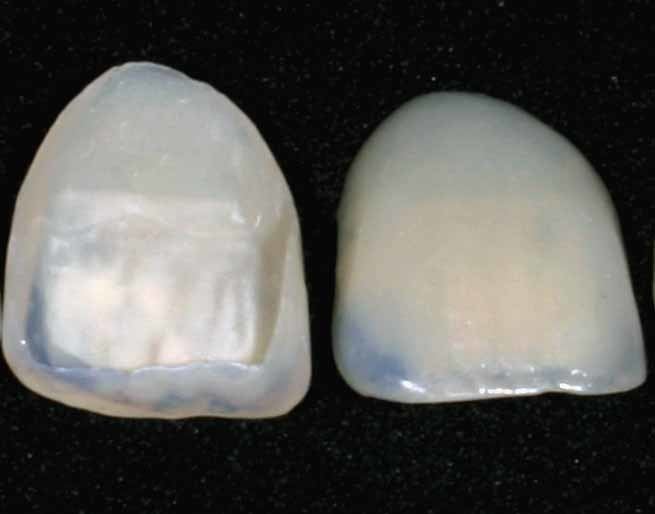MeSH D003801 | ||
 | ||
In dentistry, a veneer is a layer of material placed over a tooth, veneers improve the aesthetics of a smile or and protect the tooth's surface from damage. There are two main types of material used to fabricate a veneer: composite and dental porcelain. A composite veneer may be directly placed (built-up in the mouth), or indirectly fabricated by a dental technician in a dental lab, and later bonded to the tooth, typically using a resin cement such as Panavia. In contrast, a porcelain veneer may only be indirectly fabricated. Full veneer crown is described as “A restoration that covers all the coronal tooth surfaces (Mesial, Distal, Facial, Lingual and Occlusal)”. Laminate veneer, on the other hand, is a thin layer that covers only the surface of the tooth and generally used for aesthetic purposes.
Contents
Medical uses
Veneers are a prosthetic device, by prescription only, used by the cosmetic dentist. A dentist may use one veneer to restore a single tooth that may have been fractured or discolored, or in most cases multiple teeth on the upper arch to create a big bright "Hollywood" type of smile makeover. Many people have small teeth resulting in spaces that may not be easily closed by orthodontics. Some people have worn away the edges of their teeth resulting in a prematurely aged appearance, while others may have malpositioned tooth/ teeth that appear crooked. Multiple veneers can close these spaces, lengthen teeth that have been shortened by wear, fill the black triangles between teeth caused by gum recession, provide a uniform color, shape, and symmetry, and make the teeth appear straight. Dentists also recommend using thin porcelain veneers to strengthen worn teeth. It is also applied to yellow teeth that won't whiten. Thin veneers are an effective option for aging patients with worn dentition. In many cases, minimal to no tooth preparation is needed when using porcelain veneers.
Contraindications
In a controversial opinion, Dr. Michael Zuk, DDS from small town in Canada profiles in his opinion and problems of overuse of porcelain veneers by certain cosmetic dentists in 'Confessions of a Former Cosmetic Dentist'. He suggests that the use of veneers for 'instant orthodontics' or simulated straightening of the teeth can be harmful, especially for younger people with healthy teeth. However, in an opposing expert opinion, Dr. James W. Dunnavant, DDS from Las Vegas and New York and founder of www.1-800-VENEERS.com believes the patients benefits outweigh the small risks when the procedure is performed by a competent dentist. Leading dentists, that have little experience caution that minor superficial damage or normal wear to the teeth is not justification for porcelain or ceramic veneers. This is because the preparation needed to apply a veneer may in some cases destroy 3–30% of the tooth's surface if performed by an inexperienced dentist. Again, modern materials and in many cases in the modern age of dentistry no preparation is needed of the tooth structure to create a beautiful smile with veneers. It has been found that after 10 years, 50% of veneers are either displaced, need re-treatment, or are no longer in satisfactory condition.
Some cosmetic dentists may push unnecessarily for prosthodontic treatment in adolescents or young to middle-aged adults who have otherwise healthy teeth that only necessitate whitening or more routine cleaning. As preparation for veneers requires shaving down the tooth in some cases, sensitivity and decay may become a problem if this procedure is not properly performed. In addition, a veneer's maintenance cost can also be prohibitive for many individuals. Veneer placement should be limited to individuals with significant aesthetic problems, such as badly cracked or broken teeth, that do not meet the requirements for a crown or full replacement.
Classification
There are different types of classification for veneers. One of the recently suggested veneer classification (2012) is called Nankali Veneer Classification and divides the veneers as follows:
Alternatives
In the past, the only way to correct dental imperfections was to cover the tooth with a crown. Today, in most cases, there are several possibilities from which to pick: crown, composite resin bonding, cosmetic contouring or orthodontics.
Non-permanent dental veneers, which are molded to existing teeth, are a feasible option as well. These dental veneers are removable and reusable, and are made from a flexible resin material. Do-it-yourself kits are available for the impression-taking process, and then the actual veneers are made in a lab and sent to the wearer through the mail.
History
Veneers were invented by California dentist Charles Pincus in 1928 to be used for a film shoot for temporarily changing the appearance of actors' teeth. Later, in 1937 he fabricated acrylic veneers to be retained by denture adhesive, which were only cemented temporarily because there was very little adhesion. The introduction of etching in 1959 by Dr. Michael Buonocore aimed to follow a line of investigation of bonding porcelain veneers to etched enamel. Research in 1982 by Simonsen and Calamia revealed that porcelain could be etched with hydrofluoric acid, and bond strengths could be achieved between composite resins and porcelain that were predicted to be able to hold porcelain veneers on to the surface of a tooth permanently. This was confirmed by Calamia in an article describing a technique for fabrication, and placement of Etched Bonded Porcelain Veneers using a refractory model technique and Horn describing a platinum foil technique for veneer fabrication. Additional articles have proven the long-term reliability of this technique.
Today, with improved cements and bonding agents, they typically last 10–30 years. They may have to be replaced in this time due to cracking, leaking, chipping, discoloration, decay, shrinkage of the gum line and damage from injury or tooth grinding. The cost of veneers can vary depending on the experience and location of the dentist. In the US, costs range anywhere from $1000 a tooth upwards to $3000 a tooth as of 2011. Porcelain veneers are more durable and less likely to stain than veneers made of composite.
